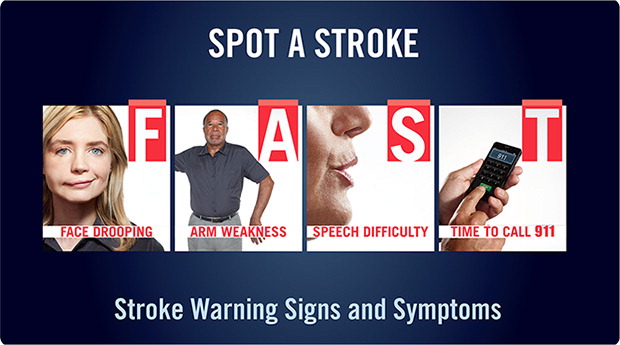What is a stroke?
The American Stroke Association defines a stroke as a disease that affects the arteries leading to and within the brain. It is the #5 cause of death, and a leading cause of disability in the United States.
A stroke occurs when a blood vessel that carries oxygen and nutrients to the brain is either blocked by a clot or bursts (ruptures). When that happens, part of the brain cannot get the blood (and oxygen) it needs, so it and brain cells die.
A stroke is a very serious medical situation. Although some risk factors for stroke can be hereditary, there are lifestyle choices you can make to reduce your risk of having a stroke.
Think FAST, Act FAST. Familiarize yourself with this Acronym to be ready to help someone in need.
The following are the top risk factors for stroke:
-
High blood pressure
- This is the No. 1 cause of stroke and the most important controllable risk factor for stroke. People who are at higher risk include overweight or obese, over age 35, have a family history of high blood pressure, African Americans, pregnant women, and those who are physically inactive, eat too much salt and/or drink too much alcohol. The American Heart Association recommends having your blood pressure checked at least every two years after age 20 if you don’t have a history of high blood pressure. Of all people with high blood pressure, more than 20% are unaware of their condition. Are you one of them? If you don’t know, see a healthcare professional to be tested.
-
Smoking
- The nicotine in cigarettes and other tobacco products makes your blood vessels get narrow and your heart beat faster, which makes your blood pressure higher. The use of oral contraceptives combined with cigarette smoking greatly increases stroke risk. Quitting smoking now can help you lower your blood pressure (among many other health benefits), which can reduce your risk of stroke.
-
Diabetes Mellitus
- Many people with diabetes also have high blood pressure, high blood cholesterol, and are overweight. This increases their risk even more. Though diabetes is treatable, the presence of the disease still increases your risk of stroke.
-
Poor diet
- Meals high in saturated fat, trans fat and cholesterol can raise blood cholesterol levels. Foods high in sodium (salt) can contribute to increased blood pressure. Diets with excess calories can contribute to obesity. But a diet that includes five or more servings of fruits and vegetables per day may reduce stroke risk.
-
Physical inactivity and obesity
- Being inactive, obese or both can increase your risk of high blood pressure, high blood cholesterol, diabetes, heart disease and stroke. So go on a brisk walk, take the stairs and do whatever you can to make your life more active. Try to get a total of at least 30 minutes of activity on most or all days.
-
High blood cholesterol
- Low HDL (“good”) cholesterol is a risk factor for stroke in men and women. HDL’s work like a tiny scrub brush cleaning the arteries, if your HDL’s are too low then there is not enough of them present to do their job.
-
Atrial Fibrillation
- The heart’s upper chambers quiver instead of beating effectively, which can let the blood pooling and clotting. If a clot breaks off, enters the bloodstream and lodges in an artery leading to the brain, a stroke results.
Recognize and Respond are two critical components of helping someone experiencing signs and symptoms of a stroke. Calling 911 at the first symptoms of a stroke greatly changes the recovery and could be the difference of someone walking out of the hospital vs. someone who no longer has use of one of their arms.
Most people know to call 911 right away when someone is experiencing chest pain, but there is still much work to do in raising the awareness of stroke signs and symptoms.


